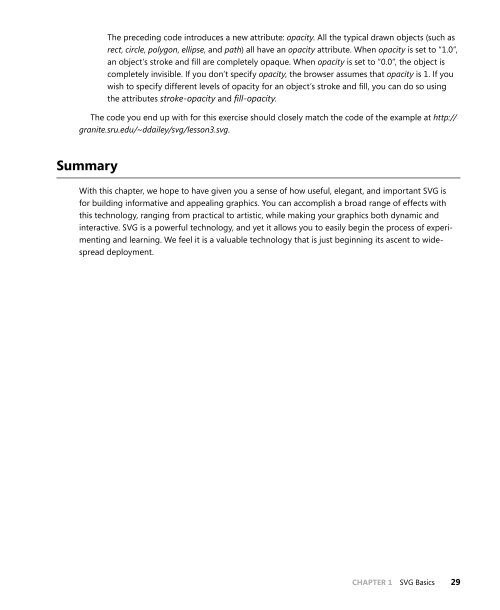Building Web Applications with SVG - Cdn.oreilly.com
Building Web Applications with SVG - Cdn.oreilly.com
Building Web Applications with SVG - Cdn.oreilly.com
Create successful ePaper yourself
Turn your PDF publications into a flip-book with our unique Google optimized e-Paper software.
The preceding code introduces a new attribute: opacity. All the typical drawn objects (such as<br />
rect, circle, polygon, ellipse, and path) all have an opacity attribute. When opacity is set to “1.0”,<br />
an object’s stroke and fill are <strong>com</strong>pletely opaque. When opacity is set to “0.0”, the object is<br />
<strong>com</strong>pletely invisible. If you don’t specify opacity, the browser assumes that opacity is 1. If you<br />
wish to specify different levels of opacity for an object’s stroke and fill, you can do so using<br />
the attributes stroke-opacity and fill-opacity.<br />
The code you end up <strong>with</strong> for this exercise should closely match the code of the example at http://<br />
granite.sru.edu/~ddailey/svg/lesson3.svg.<br />
Summary<br />
With this chapter, we hope to have given you a sense of how useful, elegant, and important <strong>SVG</strong> is<br />
for building informative and appealing graphics. You can ac<strong>com</strong>plish a broad range of effects <strong>with</strong><br />
this technology, ranging from practical to artistic, while making your graphics both dynamic and<br />
interactive. <strong>SVG</strong> is a powerful technology, and yet it allows you to easily begin the process of experimenting<br />
and learning. We feel it is a valuable technology that is just beginning its ascent to widespread<br />
deployment.<br />
CHAPTER 1 <strong>SVG</strong> Basics 29
















